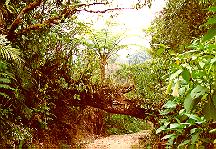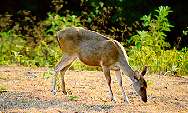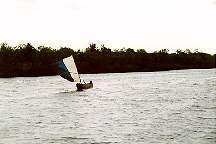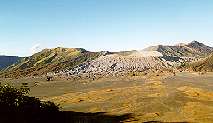
This page was last changed at 30 March 1996

|
These gardens provide an interesting place for a birding visit. They are located in the centre of Bogor. Try to avoid visiting the gardens during the weekends as hundreds of Indonesians come over from Jakarta for a picknick. The trees behind the National Herbarium are a roost for a few nice species. |
| This park is centred around the twin volcanic peaks of Gunung Gede (2,958 m) and Gunung Pangrango (3, 019 m). The habitat is mainly montane forest. Almost all the montane Javan endemics can be found here! At the base of the park are the Cibodas Botanical Gardens, which are also very good for birding. Near the guesthouse in the botanical gardens is a zig-zag path which is very good at first light. Try to avoid visiting the park during weekends and holidays when it can be crowded on the main trail. |  |
|
The park is home to many species of mammal. These include the
Stink Badger (Mydaus javanensis),
Flying Lemur (Galeopterus variegatus),
Barking Deer (Muntiacus muntjak),
Lesser Mouse-deer (Tragulus javanicus) and two species of wild pig
(Sus scrofa and S. verrucosus). Four species of primate live here: Javan Gibbon (Hylobates moloch), Javan Leaf Monkey (Presbytis comata), Ebony Leaf Monkey (Trachyppithecus auratus) and Long-tailed Macaque (Macaca fascicularis). Other rare mammals include Leopard (Panthera pardus), Leopard Cat (Felis bengalensis) and Wild Dog (Cuon alpinus javanicus). |
 Long-tailed Macaque |
|
Getting there The Park is easily reached from the main Bogor-to-Bandung road at the Puncak Pass. Catch a minibus to Cipanas and ask to be dropped at the turning for Cibodas. Take another minibus to the end of the road. Access There is a PHPA-office next to the entrance of the botanical gardens where you must buy your permit. Best is to buy one a day in advance so you can enter the park before the office opens at 7.30. Accomodation A good and cheap place to stay is Freddy's stall and Home Stay. We stayed in the guesthouse in the botanical garden. It is a bit more expensive but the view is breathtaking and you can start birding from the window in the morning! There are several food stalls in Cibodas. Try Rika's place, for good food made by Freddy's daughter. |
| Pangandaran is a small town and beach resort, popular with tourists, on the south coast of Java. There is a National Park south of the resort. On a clearing there is a hide where Banteng (wild cattle) and a few nice birds are often seen. |  |
 Javan Rusa |
Banteng (Bos sondaicus) can regularly be seen from the hide at dusk, Javan Rusa (Cervus timorensis) common, Lesser Mouse-deer (Tragulus javanicus), Silvered Leaf Monkey (Presbytis cristata), Long-tailed Macaque (Macaca fascicularis) tame, Large Flying Fox (Pterops vampyrus) they fly out over the town at dusk in huge numbers, Palm Civet (Vivvericula malacensis) and Porcupine (Histrix javanica). |

|
White-browed Crake: a few. Whimbrel: a few. Far Eastern Curlew: two. Common Redshank: a few. Terek Sandpiper: one. Common Sandpiper: common. Grey-tailed Tattler: a few. Pacific Golden-Plover: a few. Oriental Darter: a few. Little Egret: common. Grey Heron: a few. Great-billed Heron: a few. Great Egret: a few. Intermediate Egret: common. Javan Pond-Heron: common. Striated Heron: a few. Cinnamon Bittern: fairly common. Milky Stork: a few. Lesser Adjutant: fairly common. Racket-tailed Treepie: a few. Great Tit: a few near Kalipucang. Pacific Swallow: common. Copper-throated Sunbird: a few. Streaked Weaver: in the ricefields by the path along the river. Red Avadavat: in the ricefields by the path along the river. Pin-tailed Parrotfinch: in the ricefields by the path along the river. |

|
The Mount Bromo is a well-known tourist spot which is crowded with people who are gathering in the morning to see the sunrise. The bird to see here is the subspecies of Russet Bush-Warbler (Bradypterus seebohmi montis) that is split off as a seperate species by some authors. |
 Back
Back[.Home.] [.Hotels.] [.Food.] [.Money.] [.Events.] [.Resources.] [.Jakarta.] [.Industry.]